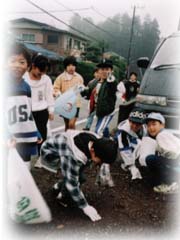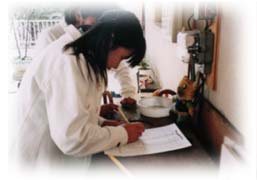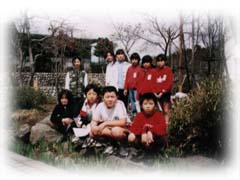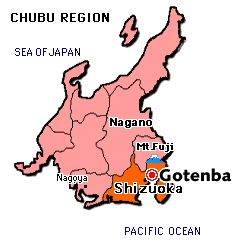Students Pursue Earth-Friendly Lifestyles
 Tamaho Elementary School is located in the city of Gotenba, Shizuoka
Prefecture, at the foot of Mt. Fuji. Surrounded by lush greenery, the school
encourages its students to come up with their own ideas about how they can lead
a more Earth-friendly lifestyle. The approximately 660 children at the school
have set up forums like the Natural Science Committee and Recycling
Committee to carry out a variety of conservation projects.
Tamaho Elementary School is located in the city of Gotenba, Shizuoka
Prefecture, at the foot of Mt. Fuji. Surrounded by lush greenery, the school
encourages its students to come up with their own ideas about how they can lead
a more Earth-friendly lifestyle. The approximately 660 children at the school
have set up forums like the Natural Science Committee and Recycling
Committee to carry out a variety of conservation projects.
One of the Natural Science Committee's activities is collecting fallen leaves and
turning them into compost. Most of the students involved are in grades
four to six; they collect the leaves on their way to and from school. The compost
is used as fertilizer for the flower beds on the school grounds. Thanks to this
effort, more than 10,000 scarlet sages, marigolds, and other flowers bloom each
summer.
 The Recycling Committee, meanwhile, collects aluminum cans and milk
cartons. Some 600 kilograms of aluminum cans are gathered each year and sold
to recycling companies. The proceeds are used for various school activities. In
April 1999 the committee began organizing collections of the cartons of milk
served with school lunch. After finishing their meal, students in grades two to
six clean and dry the cartons to make recycling easier. The volume of paper
cartons collected should total about 1 ton at the end of the program's first full
year. The cartons are being sold to paper makers in the city and recycled as toilet
paper.
The Recycling Committee, meanwhile, collects aluminum cans and milk
cartons. Some 600 kilograms of aluminum cans are gathered each year and sold
to recycling companies. The proceeds are used for various school activities. In
April 1999 the committee began organizing collections of the cartons of milk
served with school lunch. After finishing their meal, students in grades two to
six clean and dry the cartons to make recycling easier. The volume of paper
cartons collected should total about 1 ton at the end of the program's first full
year. The cartons are being sold to paper makers in the city and recycled as toilet
paper.
Besides these committee activities, the kids at Tamaho Elementary School
organize a number of events that get people to think about recycling and
protecting the environment. They also participate in projects sponsored by the
local community, distributing leaflets to raise awareness about the environment
among adults.
 School Principal Masaharu Sugiyama has been very enthusiastic about carrying
on and expanding these activities since coming to Tamaho in April 1998. One of
the things that he and the students agreed to in their discussions has been to try
to become a model "eco-school" pursuing Earth-friendly activities. As a first step,
power-generating equipment using clean energy sources like the wind (300 watts)
and sun (55 watts) were installed on the school's roof in the fall of 1998. The
generators were paid for with the approximately 300,000 yen raised from the sale
of aluminum cans and PTA-sponsored bazaars. The electricity they generate will
be used to power the lamps needed for security and in the garden. Models
showing how the energy of the wind and sun are harnessed to produce electricity
will also be built for use in science classes.
School Principal Masaharu Sugiyama has been very enthusiastic about carrying
on and expanding these activities since coming to Tamaho in April 1998. One of
the things that he and the students agreed to in their discussions has been to try
to become a model "eco-school" pursuing Earth-friendly activities. As a first step,
power-generating equipment using clean energy sources like the wind (300 watts)
and sun (55 watts) were installed on the school's roof in the fall of 1998. The
generators were paid for with the approximately 300,000 yen raised from the sale
of aluminum cans and PTA-sponsored bazaars. The electricity they generate will
be used to power the lamps needed for security and in the garden. Models
showing how the energy of the wind and sun are harnessed to produce electricity
will also be built for use in science classes.
The school felt it had to do more to deserve the title of an "eco-school." So an
appeal was made through the student body newsletter, asking everyone to send
in suggestions. The student body officers--all of them in sixth grade--compiled
the ideas that were turned in and drew up a nine-point Environment
Declaration in late February 1999. The Declaration contains pledges to pay more
attention to activities that could have an impact on the environment, such as
using erasers, pencils, paper and other supplies with more care, not littering and
picking up the litter left by others, not leaving water running unused, and
turning off lights when no one is in the room.
 "We drew up the Declaration with the hope that younger students will continue
and build on our initiative after we graduate," commented student president
Yoshiaki Nakamine.
"We drew up the Declaration with the hope that younger students will continue
and build on our initiative after we graduate," commented student president
Yoshiaki Nakamine.
"Even small things are important, like sorting the trash properly for separate
collection," Yosuke Takamura, another sixth grader, said.
An Eco-School Committee was
created in April at the beginning of the 1999 school year. It set targets like
increasing the volume of aluminum cans collected by 5% and conserving 5% more
on water, electricity, and paper. It also decided to turn the 330-square-meter
pond on the west side of the school building into a biotope--a small zone occupied
by a community of organisms living near their natural state. This will mean covering
the concrete pond and small stream feeding into it with earth and stones and planting
broad-leaf trees so insects and fish can live there. A kind of shellfish that
young fireflies feed on was also released into the pond in the hope of attracting
the insects.
The principal, Mr. Sugiyama, says that he hopes the kids learn the importance of
treating things with care from a young age. "By teaching them about the
environment while they are still children, they'll hopefully grow up to take a
more responsible attitude toward the environment as adults," he comments.
Tamaho will aim to become the first elementary school to receive certification
for complying with ISO 14001, an international environmental standard that is
usually followed by companies.
Photos: (From top) Students get the recycling spirit; a meeting of the Recycling Comittee; recording the naturally generated
electricity for the day; posing by the biotope. (Tamaho Elementary School)




 Tamaho Elementary School is located in the city of Gotenba, Shizuoka
Prefecture, at the foot of Mt. Fuji. Surrounded by lush greenery, the school
encourages its students to come up with their own ideas about how they can lead
a more Earth-friendly lifestyle. The approximately 660 children at the school
have set up forums like the Natural Science Committee and Recycling
Committee to carry out a variety of conservation projects.
Tamaho Elementary School is located in the city of Gotenba, Shizuoka
Prefecture, at the foot of Mt. Fuji. Surrounded by lush greenery, the school
encourages its students to come up with their own ideas about how they can lead
a more Earth-friendly lifestyle. The approximately 660 children at the school
have set up forums like the Natural Science Committee and Recycling
Committee to carry out a variety of conservation projects.  The Recycling Committee, meanwhile, collects aluminum cans and milk
cartons. Some 600 kilograms of aluminum cans are gathered each year and sold
to recycling companies. The proceeds are used for various school activities. In
April 1999 the committee began organizing collections of the cartons of milk
served with school lunch. After finishing their meal, students in grades two to
six clean and dry the cartons to make recycling easier. The volume of paper
cartons collected should total about 1 ton at the end of the program's first full
year. The cartons are being sold to paper makers in the city and recycled as toilet
paper.
The Recycling Committee, meanwhile, collects aluminum cans and milk
cartons. Some 600 kilograms of aluminum cans are gathered each year and sold
to recycling companies. The proceeds are used for various school activities. In
April 1999 the committee began organizing collections of the cartons of milk
served with school lunch. After finishing their meal, students in grades two to
six clean and dry the cartons to make recycling easier. The volume of paper
cartons collected should total about 1 ton at the end of the program's first full
year. The cartons are being sold to paper makers in the city and recycled as toilet
paper.  School Principal Masaharu Sugiyama has been very enthusiastic about carrying
on and expanding these activities since coming to Tamaho in April 1998. One of
the things that he and the students agreed to in their discussions has been to try
to become a model "eco-school" pursuing Earth-friendly activities. As a first step,
power-generating equipment using clean energy sources like the wind (300 watts)
and sun (55 watts) were installed on the school's roof in the fall of 1998. The
generators were paid for with the approximately 300,000 yen raised from the sale
of aluminum cans and PTA-sponsored bazaars. The electricity they generate will
be used to power the lamps needed for security and in the garden. Models
showing how the energy of the wind and sun are harnessed to produce electricity
will also be built for use in science classes.
School Principal Masaharu Sugiyama has been very enthusiastic about carrying
on and expanding these activities since coming to Tamaho in April 1998. One of
the things that he and the students agreed to in their discussions has been to try
to become a model "eco-school" pursuing Earth-friendly activities. As a first step,
power-generating equipment using clean energy sources like the wind (300 watts)
and sun (55 watts) were installed on the school's roof in the fall of 1998. The
generators were paid for with the approximately 300,000 yen raised from the sale
of aluminum cans and PTA-sponsored bazaars. The electricity they generate will
be used to power the lamps needed for security and in the garden. Models
showing how the energy of the wind and sun are harnessed to produce electricity
will also be built for use in science classes. "We drew up the Declaration with the hope that younger students will continue
and build on our initiative after we graduate," commented student president
Yoshiaki Nakamine.
"We drew up the Declaration with the hope that younger students will continue
and build on our initiative after we graduate," commented student president
Yoshiaki Nakamine.